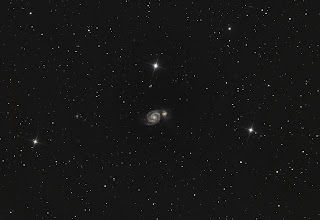.jpg)
The Owl Nebula (also known as Messier Object 97 or NGC 3587) is a planetary nebula in the constellation Ursa Major. It was discovered by Pierre Méchain in 1781.
M97 is regarded as one of the more complex of the planetaries. The 16th magnitude central star has about 0.7 solar mass and the nebula itself about 0.15 solar mass. The nebula formed roughly 6,000 years ago.
Messier 108 (also known as NGC 3556) is a barred spiral galaxy in the constellation Ursa Major. It was discovered by Pierre Méchain in 1781 or 1782.[5] From the perspective of the Earth, this galaxy is seen almost edge-on.This galaxy has an estimated mass of 125 billion times the mass of the Sun and includes about 290 ± 80 globular clusters.
Telescope: Skywatcher ED80 & William Optics FF/FR 0.8 II
Mount: HEQ5 Pro
Camera: QHY8
Filter: IDAS LPS
Guidescope: Skywatcher 70/500mm
Guide with LVI SmartGuider
Exp. Time: 2 hours(6*20 min subframes), bin 1x1
Calibration Frames: 50 flat, 50 bias, 10 darks
Capture: Nebulosity 2.2.5
Stack: Nebulosity 2.2.5
Processing: Photoshop CS3
Date: 5 April 2010
Location: Ancient Epidauros, GR
M97 - Owl Nebula Wiki
M108 Galaxy Wiki
.jpg)
.jpg)
.jpg)